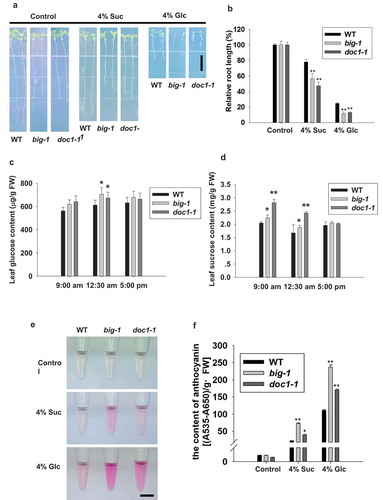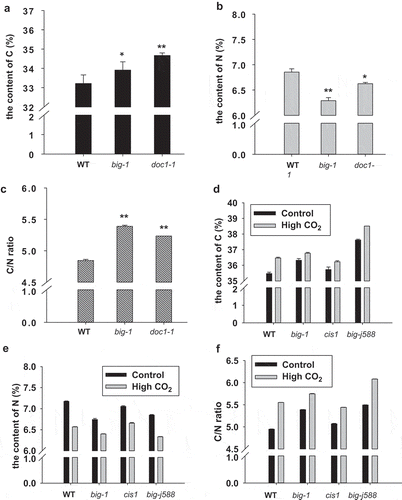Figures & data
Figure 1. BIG negatively regulates sugar responses.
(a) Representative images showing BIG gene mutants are more sensitive to sugar-mediated inhibition of primary root elongation than that wild-type Col-0 (WT). Seedlings of indicated genotypes were grown on half-strength MS medium for 4 days, then transferred to half-strength MS media with 1% sucrose (control) or with 4% sucrose or 4% glucose and grown for another 5 days before measurement. Scale bar, 1 cm. (b) Relative inhibition of primary root length was analyzed from (a). (c) Glucose levels of leaves from four-week-old WT and big mutant plants were measured. (d) Leaf sucrose content was measured in four-week-old WT and big mutants. (e) Representative images showing that big mutants are more sensitive to glucose-induced anthocyanin accumulation than WT. Seedlings were grown on half-strength medium with 1% sucrose (control) or with 4% sucrose or 4% glucose for 11 days. Scale bar, 1 cm. (f) Anthocyanin contents were measured in (e). For (b), (c), (d) and (f), asterisks indicate significant differences detected using Student’s t-test (*P < .05, **P < .01) when compared to WT.

Figure 2. BIG is important for regulating carbon/nitrogen balance.
(a) and (b) The percentage of C content was significantly increased in big mutants compared to WT, whereas the percentage of N content was significantly decreased in big mutants than WT. The C/N contents of rosette leaves from five-week-old plants were determined by elemental analyzer. (c) The C/N ratio was significantly increased in big mutants. (d) BIG gene mutants are less sensitive to elevated CO2-induced C content increase. (e) BIG gene mutants are less sensitive to elevated CO2-induced N content decrease. (f) BIG gene mutants are less sensitive to elevated CO2-induced increase of C/N ratio. For (a), (b) and (c), asterisks indicate significant differences detected using Student’s t-test (*P < .05, **P < .01) when compared to WT.

